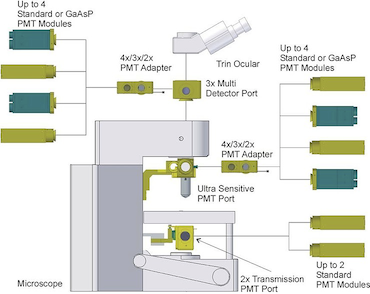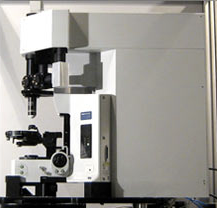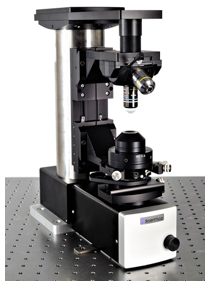Building a 2-photon microscope
Less than a year ago, the patent on 2-photon microscopy ran expired (Nov 14, 2009 pdf). So now anyone can sell a kit or system for two photon microscopy without having to pay a licensing fee.
If you don’t want to start from scratch, there are a lot of options.
Prairie Technologies
Prairie Technologies – Prairie started out collaborating with Svoboda on designs and using ScanImage, but now they have a lot of new products and have written their own software. Although their code is closed, Prairie offers very quick turnaround for interfacing with their software. So if you want to change something in the code, you can talk to the programmers and find a way to do what you want.
LaVision BioTec
LaVision BioTec is best known for the 64-beam splitting systems with high speed CCD aquisition. While this offers great speed, the imaging at depths below 50 microns is not as good as imaging with a traditional single beam + PMT approach. They also sell regular 2p scopes, including self-aligning systems.
Femtonics
Femtonics is a Hungarian company in Budapest. They sell 2D and 3D 2p systems, accessories, and caged compounds.
Sutter Instruments
Sutter Instruments sells the MOM (moving objective microscope), aka the Denkscope. This very compact design from Winfried Denk himself, places the objective on an x-y-z manipulator, leaving the prep to remain stable. In addition, the assembly can be rotated in the z-x plane. Finally, the entire scope can be easily slid away from the experimenter, to permit a dissecting scope to be positioned for the surgery. The detection pathway must be kept to a low mass, in order to allow the manipulator to function, but there are several different configurations available.
Scientifica
Scientifica has a barebones microscope platform upon which a 2p system can be built. Instead of writing their own software, they are working with the ScanImage group to make their stage compatible (ScanImage was developed for MP-285 based systems). This is an interesting system that is somewhere between turn-key and custom. It could be a great place to start for experimenters who want to build their own but not start from scratch.
Other options
Newport had an opportunity to put together a kit, but blew it. Maybe they’ll try again. The sell almost all the needed parts including the laser, they just need someone knowledgable to put together a list of SKUs.
The major microscope manufacturers (Olympus, Nikon, Leica, and Zeiss) will help you build a 2p system off of one of their scopes. For example, they might cut a hole in the side to allow you to mount non-descanned detectors in the optical pathway. They won’t build the whole system for you, of course, but they can offer a few tips and modifications to make it easier. And it goes without saying, they’ll be more than happy to sell you their turn-key systems as well (e.g., the Olympus FV1000 MPE and the Zeiss LSM 710 NLO).
I’ve built 2p rigs from scratch before. It’s really not that difficult, but it can be time consuming. Particularly if you don’t have experience with building or don’t have access to a machine shop with fast turnaround. However, there are a lot of papers and resources to help if you’d like to go that route. The Tsai book chapter (first edition) is a great one to start with. The main benefit of building from scratch is that you can optimize the optics and mechanical design to fit your planned experiments exactly.





[…] you build your own two photon scope, you’ll need software. I mainly use the MATLAB-based ScanImage. Vijay Iyer (Janelia Farm) has […]
[…] Tsai book chapter from Ron Frostig’s CRC book is a great resource for building your own 2p microscope. In section 3.3.7.2, they describe how to design the collection optics. They use a straightforward […]
Thorlabs offers a complete multiphoton microscope with a base price of $100k, and fully loaded (beam conditioner, dispersion compensation, physiology stage/microscope mover) for ~$140k [not including laser of course].
Additionally, within the next several weeks, they will be releasing an “Essentials Kit” which will include all of the major components required for homebuilders to get started immediately at a fraction of the cost of a commercial system.
imagingsales@thorlabs.com
Prairie started making the rig you picture in collaboration with me, not Svoboda, who wanted the imaging to be done in Matlab not labview (Prairie’s original imaging software). Prairie now use visual basic.
The readers are probably interested to know that you had a great deal of input on the early Prairie designs for what ended up being the Ultima product. Prairie collaborated with several labs in addition to yours, including the labs of Magee and Hausser. The in vivo scopes ended up having many elements similar to the CSHL designs (Nikon focussing mount, Olympus trinoc, etc.).
Yes, the story was that Mike Hausser asked Prairie to make an in vivo rig based on the design at CSH, which was some sort of collaboration of Denk and Svoboda? The UCL rig I am told still runs its own software that is independent of Prairie. The original software (which was only used on the first two dual 2P rigs) was a direct port of their confocal software in Labview.
In 2002 I (Graham Ellis-Davies) was introduced to Prairie by my friend Phil Haydon, who was a founding partner in the company. Kasai & Matsuzaki had just built there own dual 2P laser rig, which was used for our 2004 Nature paper. I build chemicals not software or hardware, so Prairie got interested in starting 2P uncaging microscopy. This was natural for them, as they had specialised in UV uncaging. From the very beginning they had always been able to do imaging, uncaging and e-phys in one package. Phil Haydon had wanted this.
We batted around some ideas: one was 2P uncaging with “swept field” 1P imaging. This had attractions, but in the end I said that I wanted a pure dual 2P system. In order to get this done, I was told I needed to buy 2 systems. I hardly had the money for one! So I asked Jeff Magee if he would take the risk with a company neither of us knew, and had no track record with 2P. Only BioRad and Zeiss (illegally of course) had at that time.
Jeff to his great credit saw the future. So we both gave money, in faith, to Prairie. The rest is history. Neither Magee nor I actually designed any element of the machine, it was a pure Prairie design (Bill Vogt). I provided Svoboda’s Methods paper describing the key principles of 2P design to Prairie, explaining that substage detectors would be very useful. It took a few years for these to appear! But Vogt understood the basic idea of placing the non-descanned PMTs as close to the objective as possible. The scan head he designed is still unique in having two sets of galvos in one simple box. No instrument is perfect, but the Prairie system working pretty well. The Olympus parts were used for simplicity and speed of production, not for any good design reason. Indeed Prairie have their own trinoc for their 2P mini.
If this account is mistaken in any way, please correct it! Thanks-Graham
I have no financial interest in the company.
I should add that BioRad, the 2P world wide patent holder in 2002, gave special permission to Prairie to sell their machines to Jeff & I legally.
Dear Graham,
Thank you for the story. It is very exciting to learn about the company’s history from the source.
Just wanted to add that Prairie Technologies was bought by Bruker in 2013. Besides our 2P products (Ultima and Investigator) we offer Swept-field Confocal Microscope (Opterra) and Super Resolution Microscope (Vutara).
Best regards,
[…] 2-photon laser scanning microscopes (2pLSMs) are approaching a similar turning point. With the expiration of the patent on 2pLSM and the flood of commercial interests in the market, including open source designs like the Janelia […]
Is it possible to build a 2photon microscope without using ferromagnetic metals?
Ben- Of course! You want to build one inside an MRI, I’m guessing. Two parts I can think of that it might be an issue are: (1) the galvometer scanners– scanning with AODs might be an alternative; and (2), the PMTs are sensitive to magnetic fields, so that’s something to deal with as well. Perhaps alternative detectors are in order.
It’s do-able. And an interesting engineering challenge. If you’d like to chat more about it, let me know.
Thank you for the response. I did think it shouldn’t be a problem although you point out new and interesting issues. I suppose APDs could work for the detector?
I’m not going to do it right now, as it is just a thought experiment on how to validate the BOLD response. I’m sure if it is a plausible approach then someone will do it 🙂
Here’s a simple and cheap strategy… no 2p needed. It won’t get you high resolution images, but you can get neuronal calcium signals with excellent time resolution.
1. Express a GECI (e.g., GCaMP3) in neurons of interest.
2. Use fiber optics to image calcium signals in the area: no scanning, and the detectors can be positioned far away.
[…] The original post on building a 2p scope still gets a lot of hits. Let’s revisit the topic. […]
Anyone having experience building around the Thorlabs 2P essentials kit?
Koen,
I’m now shopping around for a flexible 2p upright system. I was considering the Thorlabs multiphoton essentials kit among others. Have you made any inquires about it or demo’ed it ? I’m wondering what your experience was.
Thanks,
Mikhail
Hi Mikhail,
I looked a little into this and I think it’s a great system although Thorlabs sells very few of these. It’s truly a complete system. The only thing I would add is a reflected light path to look at the vessels pattern of the brain surface. That can be easily added by extra thorlabs parts.
Koen
The Prairie hyperlinks now go to a webpage selling Anabolic Steroids.